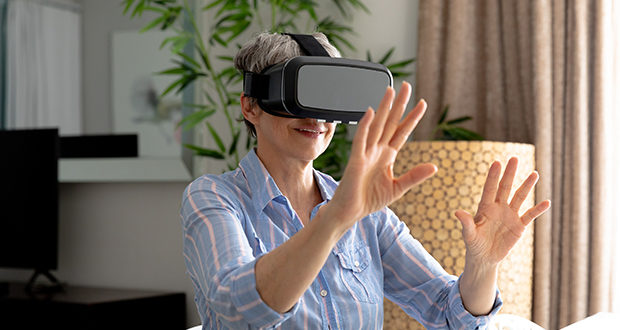As the aged care industry adjusts to COVID-19, providers will be expected to innovate to meet the growing demands for safe, age friendly living spaces.
When Safdar Ali, a Brisbane-based aged care consultant, considered these future challenges under lockdown, it was virtual reality that came up as a viable solution.
“When you are making such a large investment in your retirement, you want to be sure and feel confident that the proposed accommodation would meet your expectations or not,” he told Aged Care Insite.
“When we did our research, the best tool we thought would be virtual reality, where you would create the entire virtual environment to give customers the option to a walk the streets and go to their desired places or different points of interest.”
After spending a year in his home office, Safdar recently completed the development of the ‘Immersion-Equation’ tool.
The virtual reality headset enables potential aged care and assisted living residents, along with their families, to experience their future accommodation and lifestyle before they transition.
“It took me some time to realise that we had developed a tool which has the potential to solve many problems,” said Safdar.
“It is not a good environment for providers to attract interest and contracts for new projects or redevelopment,
“There's a service gap, and it can be breached if we offer an immersive experience to customers, where they can choose the desired property with confidence, but also giving providers some security and motivation to keep going with those projects.”
While prices do vary, the average price of a two-bedroom independent living unit in a retirement village in Australia costs around $463,000.
According to My Aged Care, entry into a residential facility can range between $50,000 and $2,000,000, with the average price reaching $359,000.
On top of the financial complexities, many prospective residents must also adhere to strict infection protocols and social distancing rules when searching for a new home.
Using virtual reality to navigate these barriers may allow more flexibility for people entering care, said Safdar.
“Another thing which we have noticed over the years is that often children and grandchildren are absent in the process, and we want their involvement,” he said.
“It becomes more exciting and you're more confident because you are receiving that validation from your family to purchase a particular apartment or room or unit,
“Although anyone can access this tool from their home, ideally we would have different events organised where we would invite the families to come and experience that as a group.”
Virtual realms: a trust exercise?
Virtual reality programs continue to gain significant traction as a modern problem solver within the healthcare industry.
Simulators have been deployed to help prep nursing students for patient conflict, expose first year midwives to live childbirth and relieve loneliness among aged care residents.
In addition to an oncoming wave of people seeking aged services, the sector continues to battle low levels of trust in the community.
Looking to advanced technologies will play a key role in rebuilding people’s expectations moving forwards, said Safdar.
“If we want to sustain this industry, we need to get that confidence back and gain that interest back,” he said.
“The outlook of this sector should be more modern than other industries because we are facing additional challenges on top of what all these other industry industries are facing,
“By using or by offering such technology or such tools, I think customers would appreciate the efforts that this industry is making to regain their confidence.”
In the next few months, Safdar plans to test out his new tool with a select group of aged care providers and apartment living projects.
He expects that people will be able to use the headset by early next year.
Do you have an idea for a story?Email [email protected]
 Aged Care Insite Australia's number one aged care news source
Aged Care Insite Australia's number one aged care news source

